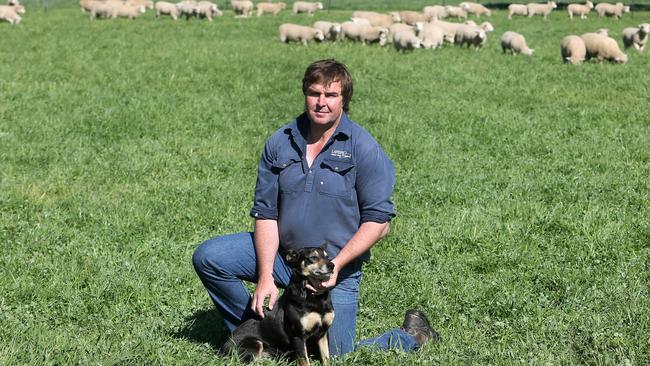Tom Bull of Lambpro sheep stud at Holbrook raises the baa
FROM humble beginnings, the Bull family’s Lambpro seedstock business has grown to become the biggest supplier of prime lamb genetics in Australia.

FROM humble beginnings, the Bull family’s Lambpro seedstock business at Holbrook, in NSW, has grown to become the biggest supplier of prime lamb genetics in Australia.
Within the next five years, their clients will be producing a million lambs collectively. The current figure is 700,000.
Tom Bull said they provided a system to help lamb producers get the highest quality trade lambs at the lowest cost of production.
“We have a simple focus on maximising kilograms of lamb produced per hectare and dollars a kilogram of carcass value,” he said.
“This approach has enabled our clients to produce some of Australia’s best trade lambs at the lowest cost of production.”
EWE TURN
TOM started out with five Suffolk sheep when he was still at school in the early 1990s and within a few years the stud expanded into White Suffolk genetics. Poll Dorsets were added in 2000 and this coincided with the early development of composite maternal lamb genetics.
In 2003 the business won a national award for innovation within the prime lamb industry. It has gone from strength to strength since. Next year Lambpro will join 4500 stud ewes.
Tom said they sold 1820 rams last year from northern NSW to southern Tasmania. The 642 rams sold at their annual sale averaged $1468.
“We take a low-key approach with our ram sale — our aim isn’t to top auction prices, it’s about getting the right genetics to the right people,” Tom said. “Our auctions are almost invite only. The reason behind this is people want price consistency.
“We have some clients who want to come along and buy a ram for $800 and they can. By keeping the prices level we don’t scare off those long-term clients.”
OUT OF THE BOX
THE Bull family’s approach is not traditional. “Our focus is on performance, not purity, and many of our sheep are hybrid,” Tom said.
“We’ve always challenged the status quo in what we do and we have the simple attitude that the market speaks. If the market changes, our mindset changes to fit that.”
The performance-recording system Lambplan has been the backbone of the business, with the breeding technology used to drive high rates of genetic gain and profitability in a commercial environment.
All sheep are run under high stocking rates, allowing those with weak constitutions to be culled and performance data to be collected under commercial conditions.
Sheep are bred to a specification, balancing traits towards low cost and high carcass-value animals.
Tom said breeding programs were tailored towards producing lambs with 18-24kg carcasses.
The key traits that form the basis of selection are leg shape, eye muscle, fat cover, growth rate, marbling and tenderness.
“The key to successful trade lamb production is having the right balance between muscle, fat and eating quality,” he said.
CHAIN REACTION
LAMBPRO has built strong relationships with leading domestic supply chains, which provides market opportunities for clients and better quality assurance for processors.
Tom said integrating progeny test programs with various markets ensured they bred lambs with the right fat, retail yield and eating quality.
He said lamb was considered a premium meat, with prices often comparable to lobster, so it needed to provide consumers with a high level of satisfaction to justify its price point.
“Lambpro genetics are bred to create increased consumer satisfaction through improved marbling and tenderness,” he said.
“The breeding program uses a combination of genomic testing and progeny testing to identify sires that will deliver consumers a better eating experience.”
Tom said Lambpro’s latest development, the Lambpro Tradie, combined Southdown marbling with Poll Dorset eye muscle.
“The outcome is a combination of high retail yield and unmatched consumer satisfaction,” he said.
EYES ON THE PRIZE
TOM’S passion for the Australian lamb industry is clear and he takes pride in supporting and educating clients to bring cutting-edge lamb production into their businesses.
“In the past two decades we have helped transform hundreds of enterprises, from beef, lamb and wool, into some of Australia’s best lamb-producing flocks,” he said.
“Lamb always has good fundamentals. The fact is we don’t have any other major exporters worldwide to compete with,” Tom said. “New Zealand is our biggest competitor, but the dairy industry there has trimmed lamb back.”
He said the biggest benefit of lamb was productivity advantages.
“Because there can be twins and triplets there is a lot of opportunity to drive up profitability — even more so than beef and wool, which is exciting,” he said.


